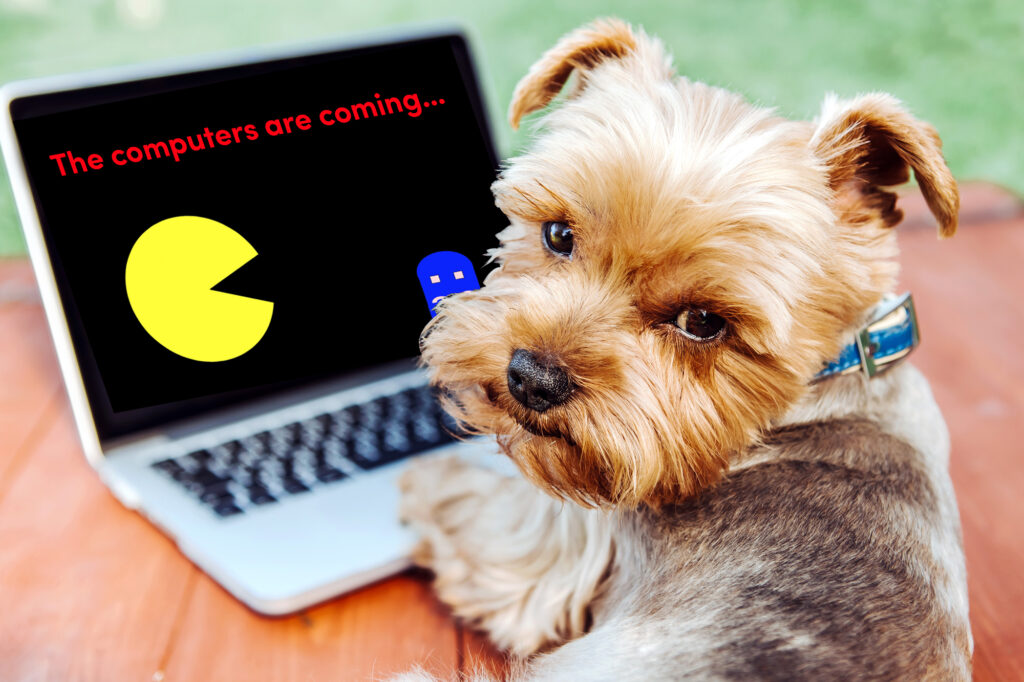Artificial intelligence has infiltrated nearly every corner of the globe, including the world of dog training. But will the field of professional dog training benefit or suffer from the explosion of AI?

We’re seeing it in almost every corner of our lives, right?
Artificial intelligence has infiltrated nearly everything we see and touch, even if we’re not always aware of it. In many ways, it is making our lives better and increasing both our personal and business-related efficiencies, no matter the topic.
Although we’re only still in the earliest days of identifying the role it will continue to play for generations to come, AI has already shown itself to be a polarizing – and often off-putting – force for change. In some ways, it seems to be contributing to the destruction of various norms and practices that not so long ago were innocently taken for granted.
And like most things in life, the world of dog training is not immune from the good – and the ills – of AI.
But what does the future look like? Will the field of professional dog training benefit or suffer from the growth of AI’s imprint? And will the relationship between dogs and the people who love them ultimately be in better or worse shape as a result?
AI Isn’t Perfect
One of the first things to keep in mind is that despite how magical it can appear, AI is not perfect.
As it literally continues to learn, AI relies to some degree on being allowed to get things wrong, despite always suggesting it’s telling the truth. From make-believe scientific sources to dangerously generalized and popular crowd-sourced concepts cloaked in the patina of presumed truths, users are finding that occasionally incorrect information is being delivered by AI with a note of brash confidence that can lead to confusion.
In a nod to the perplexing trend being normalized even by our political leaders, the individualization and secularization of truth itself is occurring in the data we receive from AI. Our biases of information have the potential of extending to the type of training advice dog lovers are receiving from AI, and this is concerning because being fed the wrong advice presented as truth can have such devastating consequences for dogs and people that live with them.
It’s Not That Simple
Usually, when we’re exploring how best to position what we have to say as experts in dog behavior, we find that the field of dog training is surprisingly unique in terms of how much nuance exists and is critical when truly understanding how dogs think, feel and learn.
Unlike some areas of expertise that rely on and celebrate definitive stances on key topics within that field, being a good dog trainer – and helping guardians manage and effect change in their dogs – requires a huge amount of seemingly trivial but critically explicit nuance.
For example, the words we use when describing what is happening with a dog are hugely revealing and important in setting the stage for successful outcomes and learning – by both human and dog. Using the word ‘dominance’, for instance, is a loaded term which many average dog guardians may take for granted as understood. (Spoiler: dominance does exist in the dog world, but not in the way most people understand it.)
When AI tries its hand at helping us with dog behavior, unless it is explicitly instructed regarding how to approach the topic with regimented rules and terminology, it can often lead a well-meaning, very intelligent human dog guardian down some accidentally erroneous (and sometimes even dangerous) paths.
So How Will AI Affect Dog Training?
We’re in the early stages of incorporating AI into our lives and workflows, and dog training is no exception.
There’s no doubt that the promise of what AI can deliver to people seeking advice about dog behavior has tremendous potential. But like with most aspects of AI, its pervasive growth also presents a giant challenge to harness its power and ensure the most ethical, accurate net benefits.
There is an old term from the early days of computing called GIGO: Garbage In / Garbage Out. Essentially, this means that the information we receive from a computer is only as good as the source information that we begin by feeding it originally. This is especially apt when considering the various tools that already exist to try and automate dog behavior advice.
It’s only anecdotal, but to us it seems like we’re already beginning to see signs of fatigue among dog guardians seeking qualified information from AI-based systems to help solve their dog behavior problems.
Unlike many industries and in part because of the nuance required of good dog training professionals, the field of dog training will be well positioned to withstand the onslaught of AI. There will always be a deep need for the skills of a seasoned and talented positive dog training pro to help navigate the intricacies and peculiarities of dog behavior.
As AI continues to proliferate, we feel confident that the dog-loving public will track more and more back towards real-life human interaction. Like AI itself, good positive dog trainers are always learning, but unlike AI, dog training pros possess the wherewithal and – even more importantly – the motivation to continually seek newer, better, more accurately-curated information.
Whether they expect it or not when they first call in a dog trainer to their home, dog guardians have always relied on dog trainers for much more than just getting a dog to sit, stay or come when called. While AI will continue to be focused on simply getting a dog to do something or to stop doing something – sometimes even with a focus on the tools and methods used to do so, nothing will replace what can be provided by a qualified human dog trainer seasoned with effective handling skills and real-world problem solving experience as well as the empathy required to connect with not just the dog, but also the human.
Dog training can often be an extremely emotional, intimate process. For most of us, our dogs are integral parts of our immediate family, and dealing with their behavior issues can be incredibly taxing and emotionally exhausting work. Only a great dog trainer will be able to read all the signals in the room – both verbalized and unheard – to set the dog/human team up for lasting and meaningful success.
And just as schools around the world continue to wrestle with how best to utilize and recognize the reality of AI in their learning environment as a new school year gets underway, the season of learning represents an opportunity for all those looking to level up the impact they can make on dog lovers in their community and beyond.
The Victoria Stilwell Academy’s mission is to serve the curious, ambitious, and driven who are called to work with dogs professionally. Despite the growth of AI in the pet industry, VSA students and graduates are entering or leveling up within a professional field that relies on truly understanding dogs and boots on the ground personal and practical skill building. AI cannot do what these professionals can and there will always be room for those committed to helping dogs and people learn to live their best lives together.
If you’re interested in gaining the skills, knowledge and confidence to make a bigger difference in the lives of those dogs and people with which you work, consider enrolling in VSA’s professional Dog Trainer Course. Plus, for a limited time, don’t miss out on a special Back To School add-on package valued at over $500 by applying with promo code BACKTOSCHOOL. Click here to learn more about the DTC and apply now.
And to make sure VSA is the right fit for you, take advantage of the opportunity to watch the actual first lesson in the Dog Trainer Course for free right now by clicking here.




